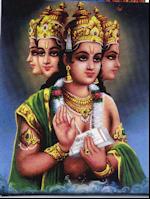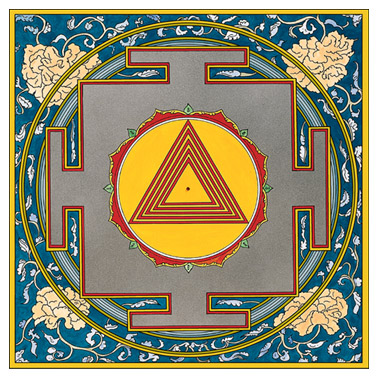
Hindu festivals
Before you look at dates of Hindu festivals, please
read a little summary of the complex and difficult-to-understand
calendar systems used in India. These systems follow
the position of the Moon (like the one used for calculation
of Christian Easter). If you want to see the
important dates of Hindu festivals immediately without
reading this introduction, click here.
This
is a very good website - you will find here also festivals for
years in the past (years such as 1920, etc.) and in the future.
 Festivals
in India occur every year and often on different dates. Of the most
common calendar systems in India we may mention the Vikrama
system, which is used in western and northern
India, in Nepal, too; and the Saka
calendar (also called Shalivahana), which is used in southern
India and in some parts of south Asia.
The year 2002 in the Gregorian calendar
corresponds to the year 2060 in
the Vikrama system and to the year 1925
in the Saka system. However, there are many variants (Bengali
calendar, for example) of calendars. These discrepancies gave birth
to ONE united Hindu calendar - a variant of the Saka
calendar was modified and established as the Indian
National Calendar in 1957.
Festivals
in India occur every year and often on different dates. Of the most
common calendar systems in India we may mention the Vikrama
system, which is used in western and northern
India, in Nepal, too; and the Saka
calendar (also called Shalivahana), which is used in southern
India and in some parts of south Asia.
The year 2002 in the Gregorian calendar
corresponds to the year 2060 in
the Vikrama system and to the year 1925
in the Saka system. However, there are many variants (Bengali
calendar, for example) of calendars. These discrepancies gave birth
to ONE united Hindu calendar - a variant of the Saka
calendar was modified and established as the Indian
National Calendar in 1957.
The Bengali Calendar
(introduced in 1584) is widely used in eastern India. The Bengali
year corresponding to the year 2010
is 1417. The Bengali year
is always 593 years behind the Gregorian
Calendar. Telugu Calendar,
for example, consists of a sixty year cycle and starts the new year
on ugadi - i.e., on Chaitra Sudhdha
Paadyami. After the completion of sixty years, the calendar starts
anew with the first year. (Ugadi, also known as Yugadi, is the Telugu
and Kannada New Year. Ugadi 2010 date is March 16. Ugadi or Yugadi
means the beginning of an era.).
The term "Panchangam"
(astrological calendar) means five attributes,
which are: Tithi, Vaar, Nakshatra, Yoga,
and Karana. Panchangam
is a Hindu astrological calendar. The above attributes have
their nature: tithi (lunar day, for example, Pratipat, Dvitiya,
etc.); nakshatra (lunar mansion - the ecliptic is divided into
27 nakshatras); karana (half of tithi); yoga (a special
calculation when the longitude of the sun and of the moon is normalized
to a value ranging from 0° to 360° and divided into 27 parts); vaasara,
often abbreviated as vaara - a day of the week (1. Ravi vasara
- Sunday [Ravi = SUN]; 2. Soma vasara - Monday [Soma = MOON]; 3. Mangala
vasara - Tuesday [Mangala = MARS]; 4. Budha vasara - Wednesday [Budh
= MERCURY]; 5. Guru vasara - Thursday [vrihaspati/guru = JUPITER];
6. Shukra vasara - Friday [Shukra = VENUS]; 7. Shani vasara - Saturday
[Shani = SATURN].
The lunar days or "tithis"
are calculated according to the angle between the sun and the moon
and are divided into two halves:
1 Pratipat
2 Dvitiya
3 Tritiya
4 Chaturthi
5 Panchami
6 Shashti
7 Saptami
8 Ashtami
9 Navami
10 Dasami
11 Ekadasi
12 Dvadasi
13 Trayodasi
14 Chaturdasi
15 Amavasya or Purnima (it depends on the calendar
system whether Dark Moon or Full Moon is accepted as the end of the
month)
The Hindu zodiac is
similar to our (Western) one - Matsya
(fish), for example, corresponds to Pisces.
Various differences in lunisolar calendars ensue
from different opinions/customs used to specify the time when a month
ends - it is either Full Moon (purnimanta)
or Dark Moon (amanta). Thus, the month
can start/end at different times in two calendar systems.
The following dates of months are based on the Indian
National Calendar (Saka), which is the united (and standardized)
calendar system introduced from the year 1957 with purpose to suppress
various confusing regional discrepancies:
Month Length
Starting
date (the Gregorian Calendar)
1 Chaitra 30/31
March 22
2 Vaishakh 31 April
21
3 Jyaistha 31 May
22
4 Asadha 31
June
22
5 Sravana 31 July
23
6 Bhadra 31
August 23
7 Asvina 30
September 23
8 Kartika 30
October 23
9 Margashirsh 30 November
22
10 Pausa 30
December
22
11 Magha 30 January
21
12 Phalgun 30 February
20
Hindu Festivals in 2013
The dates of the festival are also available
here.
The following dates do not follow the American writing style for
dates, but the DD:MM:YY format (Day:Month:Year). The dates in red
color imply that they never change.
January
13-01-2013
Lohri is the Indian festival of harvest (thanksgiving).
27-01-2013
Thaipusam, celebrated mostly by Tamils (Full Moon) in the Tamil
month of Thai, is the festival for celebration of Lord
Murugan's birthday.
February
14-02-2013
Vasant Panchami is a celebration
of Wisdom Goddess Saraswati
(Her Birthday). Yellow color is
given a special importance on Vasant Panchami.
March
10-03-2013
Maha Shivaratri or Shivaratri is a Hindu festival for
celebration of Lord Shiva; devotees spend this
night in vigilance (ratri = night) and offer Bilva leaves to Lord
Shiva.
27-03-2013
Holi is a festival of colors.
April
20-4-2013
Ram Navami is a festival for celebration of Lord Rama's
birthday.
15-04-2013
Bengali New Year.
25-04-2013
Hanuman Jayanti is the day when Lord
Hanuman's birthday is celebrated.
May
25-05-2013
Buddha Purnima / Vaisakhi Purnima. Buddha Purnima during Vaishakha
month is celebrated as birth anniversary of Gautama Buddha.
June
19-06-2013
Ganga Dashami/Dussehra is the festival for Goddess Ganga.
July
22-07-2013
Guru Purnima is the day when the birth of Vyasa
(author of the Mahabharata) is celebrated.
10-07-2013
Rath Yatra is a celebration of Lord Jagannath - in the
Vaishnava community Lord Jagannath is a very merciful form
of Lord Krishna.
August
15-08-2013
Indian Independence Day (this date never changes) that has
been celebrated from the year 1947.
20-08-2013
Raksha-Bandhan is a festival during which relationships between
brothers and sisters are celebrated.
28-08-2013
Krishna Janmashtami is a festival when devotees have the birth
of Lord Krishna in memory.
September
09-09-2013
Ganesh/Vinayak Chaturthi festival is especially dedicated to
Lord Ganesh; it takes 10 or 11 days and at
the end of it people immerse hand-made statues of Lord
Ganesh into the sea (or water). They do this because water is
the symbol of Woman (Mother). The other reason for doing this is to
indicate that all forms change, but the Supreme Truth will always
remain the same.
16-09-2013
Onam is a festival taking only place in the Indian state of
Kerala; it is celebrated in memory of the great King
Mahabali to whom Lord Vishnu (in
His Vamana incarnation) appeared and later sent him to nether
worlds. King Mahabali received Vishnu's approval to
visit his land (Kerala) every year and during this festival it is
believed that King Mahabali is with
his people. The King is one of the Chiranjeevins (the immortals
in Hinduism). When the festival ends, King goes back to his underworld
home (Patala).
October
02-10-2013
Gandhi Jayanti is the national holiday in memory of Mahatma
Gandhi.
05-10-2013
Navaratri starts. Navaratri is a Hindu festival of worship
and dance focused especially on nine nights (nav = nine; ratri = night)
in worship of Goddess Durga. On this day
Navaratri begins.
09-10-2013 (9th - 13th October 2013)
Durga puja begins.
November
03-11-2013
Diwali or Deepawali is an Indian and Nepalese festival
of lights; it signifies victory of the Celestial
Energy over the evil one. In some customs this is
also the Kali's day (Kali Puja).
08-11-2013
Chhat Puja is a festival for
Sun God.
17-11-2013
Guru Nanak Jayanti, the founder of the Sikh
faith, was born in the month of Kartik
(October/November), and his birthday is known as Guru
Nanak Jayanti, which is an important festival for the Sikh
community in India.
December
13-12-2013
Gita Jayanti is the symbolic date in commemoration of the day
when Bhagavadgita was born.
Back


